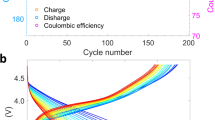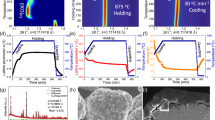Abstract
Electrochemomechanical degradation is one of the most common causes of capacity deterioration in high-energy-density cathodes, particularly intercalation-based layered oxides. Here we reveal the presence of rotational stacking faults (RSFs) in layered lithium transition-metal oxides, arising from specific stacking sequences at different angles, and demonstrate their critical role in determining structural/electrochemical stability. Our combined experiments and calculations show that RSFs facilitate oxygen dimerization and transition-metal migration in layered oxides, fostering microcrack nucleation/propagation concurrently with cumulative electrochemomechanical degradation on cycling. We further show that thermal defect annihilation as a potential solution can suppress RSFs, reducing microcracks and enhancing cyclability in lithium-rich layered cathodes. The common but previously overlooked occurrence of RSFs suggests a new synthesis guideline of high-energy-density layered oxide cathodes.
This is a preview of subscription content, access via your institution
Access options
Access Nature and 54 other Nature Portfolio journals
Get Nature+, our best-value online-access subscription
$29.99 / 30 days
cancel any time
Subscribe to this journal
Receive 12 print issues and online access
$259.00 per year
only $21.58 per issue
Buy this article
- Purchase on Springer Link
- Instant access to full article PDF
Prices may be subject to local taxes which are calculated during checkout




Similar content being viewed by others
Data availability
All relevant experimental and computational data within the article are available from the corresponding author upon reasonable request.
References
Liu, T. et al. Origin of structural degradation in Li-rich layered oxide cathode. Nature 606, 305–312 (2022).
Bi, Y. et al. Reversible planar gliding and microcracking in a single-crystalline Ni-rich cathode. Science 370, 1313–1317 (2020).
Jang, H.-Y. et al. Structurally robust lithium-rich layered oxides for high-energy and long-lasting cathodes. Nat. Commun. 15, 1288 (2024).
Singer, A. et al. Nucleation of dislocations and their dynamics in layered oxide cathode materials during battery charging. Nat. Energy 3, 641–647 (2018).
Li, Y. et al. Degradation by kinking in layered cathode materials. ACS Energy Lett. 6, 3960–3969 (2021).
Xu, C. et al. Bulk fatigue induced by surface reconstruction in layered Ni-rich cathodes for Li-ion batteries. Nat. Mater. 20, 84–92 (2021).
Kim, U.-H. et al. Heuristic solution for achieving long-term cycle stability for Ni-rich layered cathodes at full depth of discharge. Nat. Energy 5, 860–869 (2020).
Park, G.-T. et al. Ultrafine-grained Ni-rich layered cathode for advanced Li-ion batteries. Energy Environ. Sci. 14, 6616–6626 (2021).
Yan, P. et al. Intragranular cracking as a critical barrier for high-voltage usage of layer-structured cathode for lithium-ion batteries. Nat. Commun. 8, 14101 (2017).
Lin, Q. et al. Ni–Li anti-site defect induced intragranular cracking in Ni-rich layer-structured cathode. Nano Energy 76, 105021 (2020).
Meng, X.-H. et al. Kinetic origin of planar gliding in single-crystalline Ni-rich cathodes. J. Am. Chem. Soc. 144, 11338–11347 (2022).
Song, J.-H. et al. Slab gliding, a hidden factor that induces irreversibility and redox asymmetry of lithium-rich layered oxide cathodes. Nat. Commun. 14, 4149 (2023).
Ikeda, N., Konuma, I., Rajendra, H. B., Aida, T. & Yabuuchi, N. Why is the O3 to O1 phase transition hindered in LiNiO2 on full delithiation? J. Mater. Chem. A 9, 15963–15967 (2021).
Eum, D. et al. Voltage decay and redox asymmetry mitigation by reversible cation migration in lithium-rich layered oxide electrodes. Nat. Mater. 19, 419–427 (2020).
Eum, D. et al. Effects of cation superstructure ordering on oxygen redox stability in O2-type lithium-rich layered oxides. Energy Environ. Sci. 16, 673–686 (2023).
Gabrisch, H., Yazami, R. & Fultz, B. The character of dislocations in LiCoO2. Electrochem. Solid-State Lett. 5, A111 (2002).
Hong, Y.-S. et al. Hierarchical defect engineering for LiCoO2 through low-solubility trace element doping. Chem 6, 2759–2769 (2020).
Warner, J. H., Rümmeli, M. H., Gemming, T., Büchner, B. & Briggs, G. A. D. Direct imaging of rotational stacking faults in few layer graphene. Nano Lett. 9, 102–106 (2009).
Li, Z. et al. Direct observation of multiple rotational stacking faults coexisting in freestanding bilayer MoS2. Sci. Rep. 7, 8323 (2017).
Bréger, J. et al. High-resolution X-ray diffraction, DIFFaX, NMR and first principles study of disorder in the Li2MnO3–Li[Ni1/2Mn1/2]O2 solid solution. J. Solid State Chem. 178, 2575–2585 (2005).
Zhu, Y., Ophus, C., Ciston, J. & Wang, H. Interface lattice displacement measurement to 1 pm by geometric phase analysis on aberration-corrected HAADF STEM images. Acta Mater. 61, 5646–5663 (2013).
Fan, Z. Y., Rong, G., Newman, N. & Smith, D. J. Defect annihilation in AlN thin films by ultrahigh temperature processing. Appl. Phys. Lett. 76, 1839–1841 (2000).
Yamaguchi, M., Yamamoto, A., Tachikawa, M., Itoh, Y. & Sugo, M. Defect reduction effects in GaAs on Si substrates by thermal annealing. Appl. Phys. Lett. 53, 2293–2295 (1988).
Matsunaga, T. et al. Dependence of structural defects in Li2MnO3 on synthesis temperature. Chem. Mater. 28, 4143–4150 (2016).
Wang, R. et al. Atomic structure of Li2MnO3 after partial delithiation and re-lithiation. Adv. Energy Mater. 3, 1358–1367 (2013).
Gao, A. et al. Topologically protected oxygen redox in a layered manganese oxide cathode for sustainable batteries. Nat. Sustain. 5, 214–224 (2022).
Khorsand Zak, A., Abd. Majid, W. H., Abrishami, M. E. & Yousefi, R. X-ray analysis of ZnO nanoparticles by Williamson–Hall and size–strain plot methods. Solid State Sci. 13, 251–256 (2011).
Xu, G.-L. et al. Native lattice strain induced structural earthquake in sodium layered oxide cathodes. Nat. Commun. 13, 436 (2022).
Assat, G. & Tarascon, J.-M. Fundamental understanding and practical challenges of anionic redox activity in Li-ion batteries. Nat. Energy 3, 373–386 (2018).
Eum, D. et al. Coupling structural evolution and oxygen-redox electrochemistry in layered transition metal oxides. Nat. Mater. 21, 664–672 (2022).
Kresse, G. & Furthmüller, J. Efficient iterative schemes for ab initio total-energy calculations using a plane-wave basis set. Phys. Rev. B 54, 11169–11186 (1996).
Perdew, J. P., Burke, K. & Ernzerhof, M. Generalized gradient approximation made simple. Phys. Rev. Lett. 77, 3865–3868 (1996).
Dudarev, S. L., Botton, G. A., Savrasov, S. Y., Humphreys, C. J. & Sutton, A. P. Electron-energy-loss spectra and the structural stability of nickel oxide: an LSDA + U study. Phys. Rev. B 57, 1505–1509 (1998).
Ong, S. P. et al. Python Materials Genomics (pymatgen): a robust, open-source Python library for materials analysis. Comput. Mater. Sci. 68, 314–319 (2013).
Grimme, S., Antony, J., Ehrlich, S. & Krieg, H. A consistent and accurate ab initio parametrization of density functional dispersion correction (DFT-D) for the 94 elements H-Pu. J. Chem. Phys. 132, 154104 (2010).
Acknowledgements
This research was supported by the Basic Science Research Program through the National Research Foundation of Korea (NRF) funded by the Ministry of Education (2021R1A6A3A13039400, 2022R1A6A3A01086197 and 2021R1C1C2004527) as well as by the Korean government (MSIT) (no. RS-2023-00261543). This work was also supported by the Center for Nanoparticle Research at the Institute for Basic Science (IBS) (IBS-R006-A2) and LG Energy Solution.
Author information
Authors and Affiliations
Contributions
D.E. and K. Kang conceived the original idea of this study, and D.E., S.-O.P., H.-Y.J. and K. Kang designed this research project. D.E. and H.-Y.J. conducted and analysed all the experiments, with constructive advice from Y.J., S.H. and K. Kim. S.-O.P. mainly performed all the computational calculations, and J.-H.S. contributed with the preliminary results for the DFT calculations. D.E., S.-O.P., H.-Y.J. and K. Kang wrote the paper together, and K. Kang supervised all aspects of the project.
Corresponding author
Ethics declarations
Competing interests
The authors declare no competing interests.
Peer review
Peer review information
Nature Materials thanks Hui Xia and the other, anonymous, reviewer(s) for their contribution to the peer review of this work.
Additional information
Publisher’s note Springer Nature remains neutral with regard to jurisdictional claims in published maps and institutional affiliations.
Supplementary information
Supplementary Information
Supplementary Notes 1–8 and Figs. 1–24.
Rights and permissions
Springer Nature or its licensor (e.g. a society or other partner) holds exclusive rights to this article under a publishing agreement with the author(s) or other rightsholder(s); author self-archiving of the accepted manuscript version of this article is solely governed by the terms of such publishing agreement and applicable law.
About this article
Cite this article
Eum, D., Park, SO., Jang, HY. et al. Electrochemomechanical failure in layered oxide cathodes caused by rotational stacking faults. Nat. Mater. (2024). https://doi.org/10.1038/s41563-024-01899-9
Received:
Accepted:
Published:
DOI: https://doi.org/10.1038/s41563-024-01899-9



